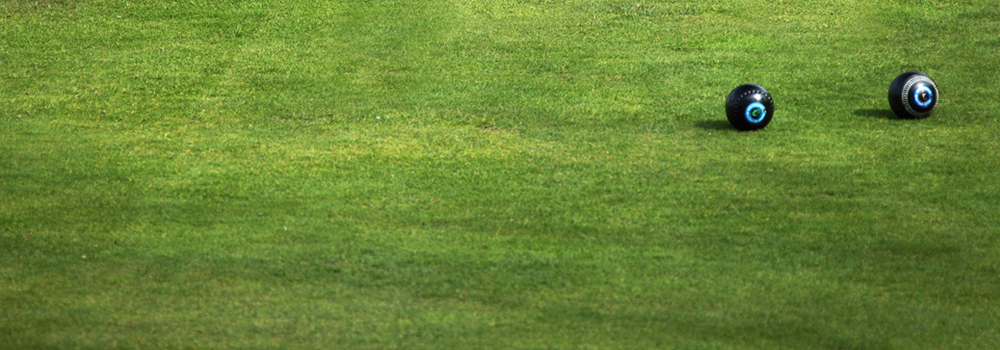
We are probably still a month behind in terms of growth, however it is surprising how quick recovery can be, especially after a input of some spring renovation work, light scarification, aeration and a timely dose of fertiliser that is activated by the very moist soil profile.
Key Tasks for June

There are still too many bowling clubs working with limited resources, often using very antiquated equipment and machinery. Many clubs have mowers that are often twenty plus years old. Nothing wrong with that, if they have been regularly serviced and are fit for purpose (sharp and able to cut to heights of 4-5 mm). For the next month or so, UK growth reaches a peak, therefore the emphasis will be on mowing frequency as long as there is sufficient moisture within the soil.
- Timely operations of feeding, aerating, watering and grooming (verticutting and brushing) are essential for the welfare of the grass plant.
- Power brush or verticut the sward to stand up any persistently straggly grass, this operation also allows for a fresher, cleaner cut.
- A light scarifying of the playing surface every 3-4 weeks can also improve the speed of the green.
- Check areas where dew is not present for signs of stress or dry patch.
- Do not underestimate the importance of watering correctly, ensuring you are watering to a consistent depth and not allow the sward to become too dry and hydrophobic.
Mowing will be the key activity, keeping the greens mown at between 4-6mm, so as not to put undue stress on the grass.
Double cut the green in a diamond formation for tournaments and finals. This type of cut removes more grass from the same area without the need to reduce the cutting height. The quality of cut is often determined by the choice of mower used. There are plenty of mowers now on the market. You usually get what you pay for! For most clubs it will be the budget available that dictates which mower they can have. There is a wide choice of manufacturers who can offer you a suitable mower (new or second hand) to suit your budgets and needs.
Irrigation. It will be important to check your watering systems, ensuring they work effectively and water the green uniformly. Watering is all about understanding the grass plants needs and knowing your soil profile; sandy soils are more free draining than loamy/clay soils. Often, problems can be as a result of low water pressure or an incorrect sprinkler. Watering is all about uniformity. Ideally, you should soak your green (flood it up) and allow it to dry out over a few days .
Fertilising. Most Greenkeepers will be applying a summer N P K fertiliser, perhaps something like a 12:0:9, reducing the N and P inputs, trying to maintain a stable balanced growth during June. You could also look to use a slow release fertiliser that will see you through July and August. The choice of material and how well it works will be dependant on factors such as soil type and weather, with moisture and air temperature being the catalyst for growth.
It is essential to ensure there is enough soil moisture present to activate the fertiliser product used. Liquid feeds are more efficient in getting into the plant, especially when used as a foliar feed.
Seeding. Seeding sparse or bare areas can be continued. The higher soil and air temperatures will help germination. Use germination sheets to aid this process, but remove the sheets regularly to check for diseases.
Topdressing is usually carried out in spring and autumn in conjunction with the renovation programmes. However, some bowling clubs have a policy of applying topdressing materials during the season. It is important that an appropriate material is sourced to ensure compatibility with the existing rootzone materials of your green. The last thing you want to encourage are rootbreaks in the green.




Now is the time to get ahead of dry patch with a wetting agent – prevention, by applying them whilst the soil is still moist, is much better than cure on baked hard massively hydrophobic soils.
Feed-wise, you should be in the middle of your programmes now, but regular applications of SeaAction seaweed and Biomass Sugar are paramount to help plant function, stress tolerance and soil biology. Where granular feeds are ticking along as a base foundation, then liquids can be used to supplement growth at specific time, such as for competitions or in-between maintenance operations to give the turf professional fine control of the plant.
For anyone who has not checked their irrigation system for accuracy and function – now would be a really good time to do it.
Monitoring the performance of your playing surfaces is a key skill that should be adopted by all Groundsman/Greenkeepers. With the aid of modern technologies, tools and a camera you can now monitor the performance and the condition of your sward in many ways.
For many years the turf industry has promoted the use of Performance Quality Standards (PQS) to ascertain the standard of sport pitch maintenance.
It is important to survey and measure the performance of your facilities, with modern technologies we can now measure all manner of aspects of the pitch/golf green or artificial pitch to ensure it meets any stated guidelines by the sports governing bodies.
These can include measuring sward height, composition of grass species, soil temperature, weed content, levels over a 3m level, hardness and infiltration rates (porosity) of the soil rootzone.
In recent years, we have seen the development of GPS mapping devices that can measure chlorophyll, moisture content and deviation in levels. Soil tests will also help determine soil type, nutrient status of the soil, organic matter content, CEC capacity and soil pH.
Keeping a record of these parameters will help you have a better understanding of what is going on within your playing surface and enable you to make better decisions on what maintenance inputs you will need to undertake to maintain surface playability.
Regular brushing and sweeping are important tasks to keep the surface clean, open and dry. A dry surface will aid resistance to disease. Keep an eye on fungal disease attack and use approved fungicides to treat infected areas. Fusarium has been quite prolific, with some surfaces getting severely scarred. Use appropriate fungicides to control any further outbreaks, however, with the grass soon beginning to grow, it won't take long for these scars to grow out.
Fairy rings are also quite prominent on greens at the moment. A dose of feed or liquid iron will stimulate some grass growth and this will help mask the fairy ring patches.
Worm activity will increase as the soil temperatures begin to rise and the soils remain moist. It may be necessary to apply an approved product to control worm activity.
A selective weed killer will help control any broadleaf weeds, the timing of application is key, apply when weed growth is vigourous.
Please note: More information on these and many others can be found here: https://www.pitchcare.com/useful/diseases.php
You should have had your mower serviced and sharpened ready for the new season.
- Keep machines overhauled and clean.
- Inspect and repair any watering or irrigation systems.
- Continue to check and service your floodlighting systems.
- Replace any worn tines on your aeration equipment.
Keep in a stock of seed and topdressing to fill in any bare patches that might occur.

Delegates attending the Bowling Green course and using the accompanying manual will be able to develop their own skills, working knowledge and expertise, by understanding the method of instruction and the maintenance principle it sets out.
Included in the Course Manual, there are working diaries showing the range of tasks needed to be accomplished each month. The Course Manual is available for purchase separately.
In addition, we are able to arrange courses to be delivered on site to groups of 6 – 10 people. Email Chris Johnson for information.
- Many bowling clubs have hedges surrounding their greens. June is a good time to trim and reshape these, thus reducing any potential shading or access problems.
- Check and inspect ditches, floodlights, structures and any site furniture for damage; keep the site clean and maintain a tidy appearance throughout the facility.
- Ensure you mowers are kept clean and set, nothing worse than a badly adjusted mower


